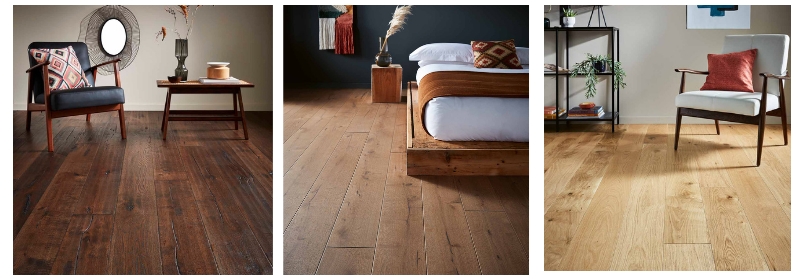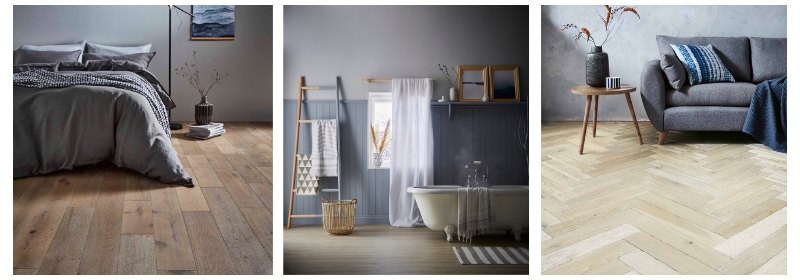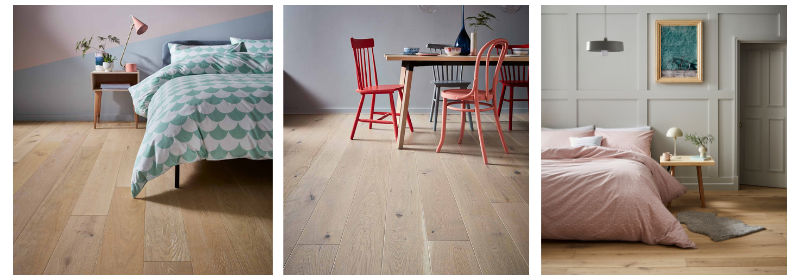Top 2021 Décor and Flooring Design Trends
Needless to say, we will all be keen to see the back of 2020 and find out what 2021 has in store for us. After spending the majority of this year at home, most of us have had plenty of time to reconsider our interior design choices. With this in mind, we’ve predicted which décor and flooring designs will take off in 2021...
Japandi
Characterised by simplicity, minimalism and functionality, ‘Japandi’ is the harmonious blend of Scandinavian and Japanese design. As we move into 2021, there appears to be a growing interest in sustainability. Studies have shown that as a result of the pandemic, over a third of consumers are now more environmentally conscious in their purchasing habits.* As a result of this, we are now observing a notable shift in people’s interior design choices, with more and more opting to focus on nature and the natural world.
‘Japandi’ helps to connect living spaces with nature by ‘bringing the outside in’ with an array of plants, greenery and sustainably sourced materials. The trend transforms the home into a tranquil space as it focuses on colours and textures that surround us in nature, such as linens, terracotta and greenery. A rich smoked oak flooring, such as Ness Smoked Oak, is a great choice to compliment this earthy palette. Or alternatively, to achieve the light and spacious minimalist look, choose a muted natural toned floor, such as Chiswick Oak.

Rustic Vogue
A sophisticated take on the hugely popular ‘Cottagecore’ aesthetic of 2020, ‘Rustic Vogue’ is the perfect blend of the traditional farmhouse with the modern comforts of city living. As we move into 2021, we are seeing a shift from city to rural, as the home becomes a calm and serene haven away from the hustle and bustle of city life.
‘Rustic Vogue’ can be characterised by raw woods, soft textiles and limewash colours, with hints of sleek design and modernist touches. This trend encourages natural elements and celebrates the beauty of imperfections, such as exposed wooden beams, tumbled linens and woven textures. Flooring with exposed knots, such as Wyvis Smoked Oak, will help to create the illusion of raw wood. Or alternatively, for a more rustic and weathered aesthetic, a white-washed wood such as Mayar Oak should be selected.

Regal Revival
Drawing inspiration from the ‘Arts and Crafts’ movement of the 19th century, ‘Regal Revival’ is a sophisticated fusion of Gothic grandeur and contemporary minimalism. Born as a response to industrialisation and mass machine-produced items, the ‘Arts and Crafts’ movement celebrates simple and honest craftsmanship. Moving into 2021, our ever-growing reliance on digital technology has meant that people seek to find solace in handcrafted products within the home.
Characterised by deep tones, wall panelling and parquet flooring, ‘Regal Revival’ transforms the home into a place of self-expression and traditional charm. Deep-toned parquet flooring, such as Sloane Smoked Oak, will help to complete the ‘Regal Revival aesthetic, as the rich deep coffee tones add luxury and style. The parquet blocks can be laid in a range of patterns to suit your individual style, helping you to personally connect with the flooring in your home.

Vivid Zonal
Distinctive and bold, ‘Vivid Zonal’ is an energetic and optimistic style that breathes new life into minimalist interiors. Brightening up the home using colours to create areas for work or relaxation, this post-modernist inspired trend is for those unafraid to experiment with unorthodox materials and features.
Characterised by sleek, non-decorative mouldings, colour blocking and DIY furniture, ‘Vivid Zonal’ is playful yet sophisticated and considered. The trend focuses on muted flooring and furniture combined with bold paint choices and colourful décor, and so to achieve this look, you should opt for a flooring with minimal colour. Manoa Oak has a delicate grain that seeps through the chalky finish, creating a distinctive style which can help draw emphasis to the vivid colourways of trend.

To view our full collection, visit: https://akirby.co.uk/shop.
*https://www.liveareacx.com/blog/pfs-livearea-research-consumerism-conscious-commerce/
Manufacturer and supplier of premium hardwood flooring, Atkinson & Kirby, has relocated its headquarters to Chirk, North Wales, joining the company’s existing onsite manufacturing and distribution facility. As part of the ongoing development of the company, Atkinson & Kirby has relocated its office headquarters to join its existing manufacturing and distribution facility in Chirk. The move will improve both the service and quality of products by having all staff in one location, unifying working relationships between all departments, from marketing to distribution, as well as improving efficiency, customer service and delivery. Atkinson & Kirby still retains its office and distribution in Livingston. Tradition is an integral part of Atkinson & Kirby and the company is proud to remain one of a few British manufacturers of hardwood flooring, with a selection of solid flooring being produced in its Chirk mill. Tony Miles, CEO of Atkinson & Kirby, comments: “The consolidation of all offices to Chirk is a big move and demonstrates just how serious we are about British manufacturing and sustainability. “We are FSC® certified and take pride in the quality of wood we supply, with rigorous inspections at various stages of production, making sure the wood is always from a sustainable source. “We are a family business and above all, excellent quality and customer service are our priority. The move is already proving successful, with a unified workforce, improved communication and efficiency.
READ ARTICLEWhat is toxic flooring? Some forms of vinyl and laminate flooring are considered to be toxic. This is because certain types can contain reprocessed plastic and other toxic chemicals including cadmium, toxic phthalates and lead. These flooring materials can give off toxic fumes that can impact air quality through a process called off-gassing. By contrast, natural building materials and healthy flooring are made with products that are free from harmful chemicals. These types of flooring - including natural stone and wood floors - are considered 'low VOC' (Volatile Organic Compounds). Sometimes, even those who shop carefully and make lifestyle choices to build a 'chemical-free house' can find that they've overlooked their flooring manufacturers and products. What is off-gassing? In simple terms, off-gassing is the process by which dangerous chemicals are released into the air. An easy-to-recognise example might be the smell of wet paint - when you sniff that recognisable scent, it means the chemicals in the paint have risen into the air. Of course, some smells and fumes are harmless to our health, but others - particularly those with dangerous chemicals or toxins - can have a serious impact. Who is at risk from off-gassing? Anyone can be affected by the toxic chemicals in certain flooring and building materials. However, typically babies and young children are among the most susceptible to the effects of toxic air quality. Adults and those with weakened immune systems or respiratory issues can also experience strong symptoms from inhaling the fumes. In the case of toxic flooring - for example, certain types of vinyl floors - it's likely that anyone who spends a lot of time close to the material itself will be the most affected. This can mean toddlers crawling around, as well as pets. What are Volatile Organic Compounds (VOC)? Volatile Organic Compounds (VOCs) are gases that are emitted into our air from various products. They can be standalone harmful chemicals that are dangerous on their own, however sometimes VOCs react to other gases or chemicals to create other pollutants. In flooring material, VOCs can commonly be found in products like stains, varnishes, adhesives and certain finishes. Natural materials - such as solid wood flooring or hardwood flooring - are generally classed as 'low-VOC'. High levels of exposure to VOCs can be harmful to the environment and health. What are formaldehyde emissions and how do they relate to low VOC flooring? Formaldehyde emissions are some of the most common VOCs. The EPA classes formaldehyde fumes as a 'probable human carcinogen'. Formaldehyde is sometimes used for its bonding qualities, so can be found in plywood, top coats, vinyl adhesive and more. It can irritate the eyes, nose, throat and skin. Significant exposure can also cause cancer. Once you know to look out for formaldehyde fumes, you'll be able to identify which flooring is the safest and best to use. A product labelled as ULEF (ultra-low emitting formaldehyde) is certified at the highest category and is the best choice for homes - though it likely contains formaldehyde, it emits fumes at extremely low levels. Formaldehyde can also be found in the emissions from vinyl flooring adhesive and the base layer of many laminate flooring types. A product labelled NAUF (no added urea formaldehyde) is essentially the next best thing. These products don't use urea formaldehyde, which causes the fumes to be released for the entire life cycle of the product. Instead, these products use alternative glues and release around 90% fewer formaldehyde emissions. Read on for our guide to non-toxic flooring. CARPET Carpet has traditionally been a popular choice of flooring, however as we become more aware of the health risks associated with carpet flooring, many people are searching for more natural eco-friendly flooring options, also known as green flooring options. There are many areas in which harmful chemicals could be used within synthetic carpet, including the dye used to colour the carpet, adhesives used to bind carpet fibres, and the dangerous chemicals used to create resistance to stains. New carpet installation is a large contributor to indoor air pollution - a recent EU study identified over 59 hazardous substances found in carpets. Synthetic carpet can hold these dangerous chemicals for months, if not years. However, there are ways to limit exposure. If you are set on choosing a carpet or a rug for your home, place the rug outdoors or in a well-ventilated area for at least a week, as the first few weeks are when the carpet expels the most toxic fumes. HARDWOOD FLOORING There are two types of hardwood flooring, solid or engineered. When installing hardwood floors the most common option is to glue the floor down. There are many safe, non-toxic glue options that you can use, speak to your installer about sourcing non-toxic glue. Alternatively, flooring profile options have advanced including 5G click, which simply clicks together allowing you to ‘float’ the floor, without requiring glue. SOLID HARDWOOD FLOORING Solid hardwood flooring is considered the safest and least toxic option as it’s completely natural and free from any toxins. Solid hardwood floors are made of planks milled from a single piece of timber, which makes it a healthy flooring option. Solid wood flooring has many advantages, including its durability, with proper maintenance and care, solid wood flooring can last a lifetime. This type of flooring is also zero-VOC and has no off-gassing qualities since it's made with natural materials. For an even more eco-friendly option, choose 100% FSC-certified wood floors, as the timber used to produce the floor comes from legal sustainable sources. However, as solid hardwood floors are 100% wood they can’t be used in moist areas, including bathrooms and basements. ENGINEERED HARDWOOD FLOORING Engineered hardwood flooring has low toxicity and similar advantages to solid hardwood flooring, but it can also be used with underfloor heating. Engineered wood floors are made from multiple layers of engineered wood for extra stability. Because it is created using natural wood, it has zero to low VOC levels. LAMINATE FLOORING Laminate flooring mimics hardwood, but instead uses synthetic wood. Unfortunately, due to the toxins and chemicals in the bonding adhesives, laminate isn’t the safest option for non-toxic flooring. CERAMIC TILES Ceramic tiles are another safe flooring option, as the tiles are usually made from non-toxic materials. However, as tiles require a thin-set mortar for the tiles to adhere to, as well as grout to fill the spaces between each tile. While the tiles themselves do not contain these harmful chemicals, it is possible that these products do. Therefore, it’s a good idea to check all components when opting for tile flooring. VINYL FLOORING Vinyl flooring and luxury vinyl plank types have become extremely popular in recent years, thanks to their durability and budget-friendliness. However, while good quality vinyl plank and tile is a viable option for flooring projects, some types of vinyl flooring have historically been found to have phthalates in them, which can be harmful due to off-gassing. These days, most vinyl flooring from quality, trustworthy manufacturers have drastically reduced VOC levels. Specifically, vinyl plank and luxury vinyl plank or luxury vinyl tile flooring are low in VOCs and at low risk for off-gassing. Rolled vinyl flooring is typically higher in off-gassing risk levels. IN SUMMARY When choosing your flooring, it’s best to opt for the most natural materials and products for a non-toxic home that is safe for pets and children. Atkinson & Kirby is committed to supplying non-toxic hardwood flooring, with solid hardwood floors being manufactured at our mill in Britain. All of our hardwood floors are FSC® and PEFC®, meaning you can be sure the timber was sourced from sustainable forests. View our solid hardwood floors or engineered hardwood floors. If you would like to order a sample or speak to one of our experienced customer service team, contact us here.
READ ARTICLE